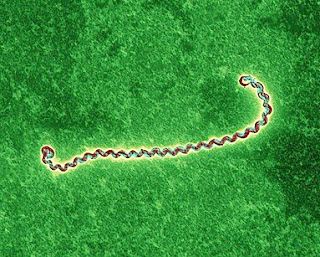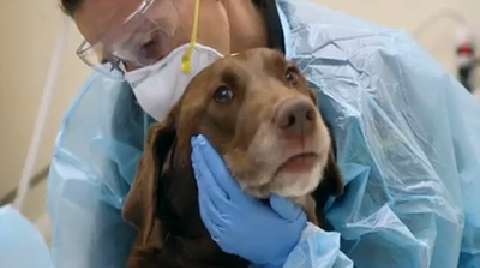To start, let me address the cat people for a moment. Cats CAN become infected with leptospirosis, but seldom develop signs of disease – they are thought to be resistant. There is not a vaccination available for the cat. However, there is still LOTS we don’t know. Many cats have chronic kidney disease and have never been tested for lepto – could some of these cats have had a previous infection, did not show clinical signs, and were therefore not treated? Are some of the increasing number of feline chronic kidney cases latent results of previous leptospirosis infections? Maybe. I certainly don’t have the answers. There is much more research that needs to be done.
On to our canine friends:

Leptospirosis is caused by a spirochete (spiral-shaped, like rotini pasta) bacterium of the genus Leptospira. There are sixteen species of Leptospira; L. interrogans is the species of interest to us. There are over 200 serovars (varieties) that can infect animals and humans. The most common serovars sound like alphabet soup: canicola, icterohaemorrhagiae, grippotyphosa, pomona, hardjo, bratislava, and autumnalis. There will be a test at the end of this blog. Just kidding!

Leptospira species flourish in warm, moist environments, including stagnant or slow-moving water. The bacteria are spread by infected urine, bite wounds, ingestion of infected tissues, venereal, or placental transfer. Indirect transmission occurs through contact with water sources, soil, food, and bedding infected with contaminated urine or other tissues. They can penetrate mucous membranes, wet skin, or broken skin. Leptosporosis can be spread by urine from infected cattle, opossum, horses, rats, foxes, deer, pigs, coyotes, infected dogs, squirrels, and pigs. It’s ZOONOTIC –which means it can be passed from animals to people. Symptoms in humans can be like flu symptoms; if you have more questions about lepto in people please check out the CDC website: https://www.cdc.gov/leptospirosis/

Once in your dog’s system, organisms attach to the cells lining blood vessels and cause inflammation of the vessels. This leads to bleeding that then spreads the organisms through the blood stream to the kidneys, liver, spleen, eyes, genital tract, and central nervous system. There is an incubation period of 7 days after initial infection before your dog’s immune system mounts a response and antibody production occurs. Leptospira organisms are found in the renal tubules within 2 weeks of infection, which means the affected animal sheds contagious organisms in urine by that time. The bacteria can stay in the kidneys and be shed for weeks to months. Significant compromise of kidney function and blood flow to the kidneys occurs due to the large amount of damage caused by these little spiral terrors. The liver is the second-most damaged organ, experiencing hepatocellular necrosis (death), occlusion of bile ducts, fibrosis, and chronic hepatitis.
How do I know if my dog is infected? What are the symptoms?
Unfortunately, clinical signs are widely variable – ranging from no signs of illness, to mild disease, to severely sick, to death. Fever, shivering, muscle tenderness, reluctance to move, increased thirst, changes in frequency or amount of urination, dehydration, vomiting, diarrhea, loss of appetite, lethargy, jaundice, and painful inflammation of the eyes are just some of the symptoms you may see. An infected dog may also experience kidney failure, liver failure, or dyspnea (difficulty breathing) with severe lung disease. Bleeding disorders are also noted. Your dog may vomit blood, have bloody stool, experience nose bleeds, have inexplicable bruising, or have fluid collect in the chest or abdomen.
How do you diagnose the disease?
First, we start with the minimum database, or MDB for short. The MDB is exactly what it sounds like – the minimum amount of information necessary to start making a diagnosis. This is the same information we need for almost any disease process, and the baseline values we collect on annual blood work when your dog is healthy. The MDB includes, but is not limited to: a complete blood count, organ function tests (chemistry profile), urinalysis, and thyroid level. Your pet may also need fecal testing, radiographs of the chest or abdomen, and ultrasound of the abdomen. Next, if the clinical signs and lab work suggest lepto infection, we would send blood or urine for PCR testing for Leptospira organisms. PCR (polymerase chain reaction) tests look for the DNA of the bacterial agent in question.
If my dog has leptospirosis, how do you treat it?
Treatment needs to be early and aggressive for a good chance at recovery. BUT, even if your dog recovers from the initial course of disease he or she can still have permanent kidney or liver damage with associated complications. Your dog will most likely need to be hospitalized with IV fluids, antibiotics, and other supportive care. Because the disease is zoonotic, any hospitalized infected dogs are kept in isolation with strict biohazard disposal protocol. Once an animal is healthy enough to go home, you still need to take precaution about exposure to their urine – avoid contact with the urine, encourage your dog to urinate away from standing water or where other people or animals have contact, and wash your hands after handling your pet. Persons who are ill, immunocompromised, or pregnant should contact their physician for advice.

At this point, you may be thinking: “Gee, Dr. H, this sounds pretty terrible. How do I prevent this from happening to my four-legged best friend?” Well, it just so happens we have a vaccine for leptospirosis! The vaccine will last for 12 months, and at-risk animals should be vaccinated annually. Risk factors include dogs exposed to livestock, wildlife (and their urine), crowded kennels, and urban areas (rodents and their urine). Four serovars are included in our vaccine: canicola, grippotyphosa, icterohaemorrhagiae, and pomona. There is cross-protection between serovars. This means that the antibodies your dog makes to the serovars in the vaccine will protect him or her from illness caused by other serovars. So, we don’t need all 200 serovars in a vaccine. However, even a vaccinated animal may potentially develop infection from a serovar not included in the vaccine. This is rare, and vaccinating is still a good choice. A vaccinated animal will have a mitigated (less severe, serious, or painful) course of disease versus an immunologically naïve (non-vaccinated) animal.

You may read about vaccine reactions to leptospirosis. The most common reactions to any vaccine include “discomfort and local swelling at the vaccination site, mild fever, and decreased appetite and activity (AVMA brochure, see below).” Rare, but potentially life-threatening reactions may include “persistent vomiting or diarrhea, hives, swelling of the muzzle, face, neck, or eyes, severe coughing or difficulty breathing” as with an anaphylactic reaction (AVMA brochure, see below). Most pets will recover from a vaccine reaction – but with lepto, your dog may never go back to “normal.”
I hope this blog has been informative – if you have any questions or concerns, don’t hesitate to give us a call. And if you realize that your pet is at risk for lepto, please schedule an appointment for a vaccine today!
Here’s to Happy, Healthy Pets!
Dr. Lauren Hendren
Sources:
Feline Leptospirosis, 11/2012, Clinician’s Brief (Capsule), Ewan Wolff, DVM
http://www.cliniciansbrief.com/article/feline-leptospirosis
Leptospirosis (Zoonotic), Rhea V. Morgan DVM, DACVIM, DACVO 1/29/2004, revised by Kari Rothrock DVM 1/20/2012
http://www.vin.com/Members/Associate/Associate.plx?from=GetDzInfo&DiseaseId=1174
Leptospirosis brochure, AVMA
https://www.avma.org/public/PetCare/Pages/Leptospirosis.aspx
Vaccinations: What to Expect After Your Pet’s Vaccination, AVMA brochure
https://www.avma.org/public/PetCare/Pages/What-to-expect-after-your-pets-vaccination.aspx
